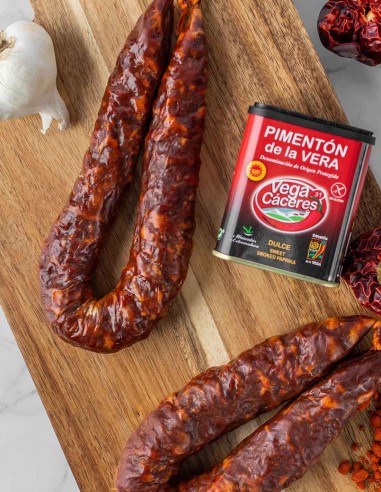I still remember the moment I fell in love with real Spanish chorizo. It was not the pale, greasy imposter I had scattered on a frozen pizza years before. No, this was in a tiny, noisy tapas bar in Madrid, a place where the floor was sticky and the laughter was loud. The slice was dark, almost crimson, and when I bit into it, my brain did a little happy dance. It was smoky, garlicky, rich with paprika, and complex in a way I did not know a sausage could be. That single bite kicked off a years-long obsession. I had to know everything about this incredible food. What is it about this sausage that makes it so special, so different from anything else? This is the story of my obsession with authentic Spanish chorizo, a journey into its history, its many varieties, and why this flavorful sausage has become a global culinary star.
It turns out, chorizo is so much more than seasoned pork; it is an edible piece of history, a story of survival, and a testament to how one ingredient can change a culture forever. Chorizo’s story is, fundamentally, a story of practicality. Imagine a time before refrigeration in the Spanish countryside. The annual pig slaughter, known as ‘la matanza,’ was a vital community event. Every single part of the animal had to be preserved to feed families for months. Chopped pork, stuffed into natural casings and cured, was a brilliant solution. But for centuries, those sausages were pale.
Then, everything changed. Spanish explorers brought back something magical from the Americas in the 16th century: paprika. Can you imagine Spanish food without that vibrant red spice now? I certainly can not. This was the revolution. That introduction of pimentón did not just add color; it added a smoky, sweet, or spicy depth that defined an entirely new category of sausage. It is the soul of chorizo as we know it today. One of the most beautiful things I have discovered is that there is no single “chorizo.” Travel across Spain, and the sausage changes its personality with the landscape. It is like a culinary dialect. It is this incredible diversity that makes exploring Spanish charcuterie so rewarding. In La Rioja, for instance, the chorizo carries this incredible smokiness, traditionally cured over holm oak wood. Then you have Chorizo de León, which hits you with a powerful, wonderful punch of garlic. Meanwhile, up in Pamplona, they grind the meat super fine, creating a firm, sliceable sausage that is just perfect for sandwiches. And then there is the king of them all, in my opinion: Iberian chorizo. This is something else entirely. It is made from those special black-hoofed pigs that roam the oak forests, feasting on acorns.

The meat is richer, almost nutty, and when it is slow-cured in a thick casing, the flavor becomes something incredibly deep and complex. Tasting it side-by-side with a standard chorizo is a revelation. Now, here is where the story gets really interesting. When the Spanish went to the New World, they brought their food traditions with them. But you can not just recreate home in a new land. You have to adapt. And adapt they did, creating something that is now uniquely Mexican. Mexican chorizo is like the wild, spicy cousin of its Spanish ancestor. It is almost always sold fresh, so you have to cook it. Instead of relying on Spanish paprika, Mexican cooks used what was local and vibrant: native chili peppers.
The result is a chorizo that is often much spicier. They also typically use vinegar instead of white wine, giving it a tangy kick that works beautifully in their cuisine. It is a brilliant example of a recipe evolving, of immigrants making a new home through the food they love. So, how do you actually use this wonderful ingredient? Well, the cured Spanish chorizo is a superstar all on its own. A few slices on a board with some manchego cheese and crusty bread is my go-to easy dinner when I do not feel like cooking. It is a perfect, no-fuss meal. But do not stop there. When you cook with it, chorizo becomes a flavor bomb. I love to sauté slices until the paprika-infused oil renders out. That red-hued fat is liquid gold. I will toss in some onions and garlic, then add a can of chickpeas or white beans for a simple, incredibly flavorful stew. It is my weeknight dinner hero.
Crumble fresh Mexican chorizo into your scrambled eggs, and you will never look back. The fat from the sausage seasons the entire pan, transforming a simple breakfast into a fiesta. As chorizo has gone global, I have noticed it pop up everywhere, from high-end restaurants to my local supermarket. While I love that this means more people can enjoy it, it also means there is a lot of mediocre chorizo out there.
So how do you find the good stuff? Look for a short ingredient list: pork, paprika, garlic, salt. That is it. Avoid anything with weird preservatives or fillers. The color should be a deep, brick red, not a neon pink. And if you can, seek out a local specialty store or a reputable online retailer that specializes in Spanish products. Trust me, the difference between a mass-produced chorizo and a properly cured, artisanal one is night and day. It is worth the extra few dollars for the real experience. At its heart, chorizo’s magic is its pure, unapologetic flavor. It is a reminder of where food comes from, of tradition, and of the beautiful accidents of history that give us our favorite foods. It started as a way to survive the winter and became a gift to the world. Now, if you will excuse me, all this writing has made me hungry. I think I have some chorizo in the fridge calling my name.
References
Royal Spanish Academy. (1726). Dictionary of Authorities: Historical definition of chorizo. https://www.rae.es/
European Commission. (2024). Protected Geographical Indications: Spanish chorizo varieties and quality standards. https://ec.europa.eu/agriculture/quality/
International Journal of Gastronomy and Food Science. (2024). Paprika’s impact on European sausage production and flavor development. https://www.journals.elsevier.com/
Food and Agriculture Organization. (2024). Global meat trade: Specialty cured products and market dynamics. https://www.fao.org/

